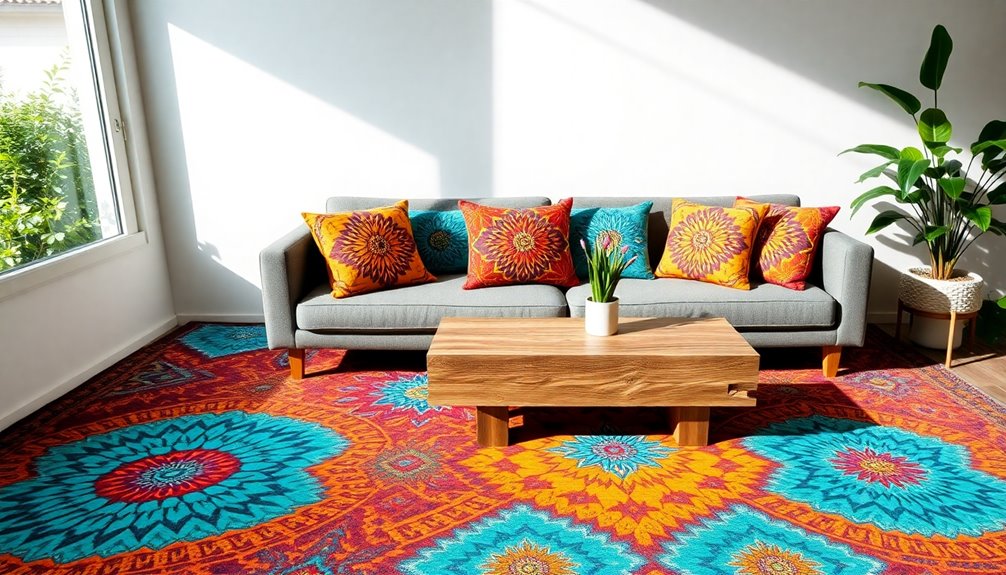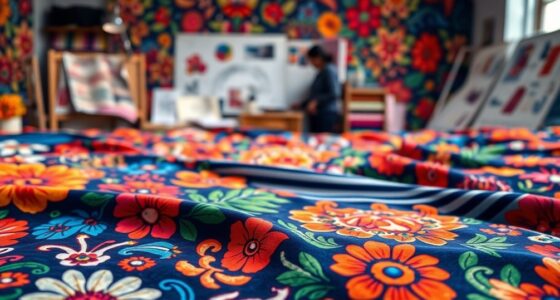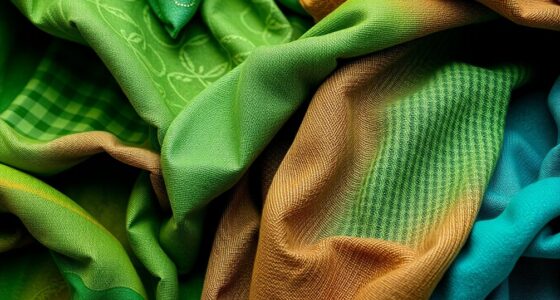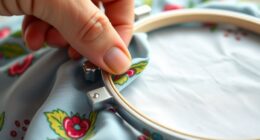Textile transformation for modern home décor involves blending traditional techniques with cutting-edge technology. You'll notice vibrant patterns and textures that elevate your space, often using sustainable materials. Color choices can set the mood, while innovative designs like fabric panels and smart textiles offer functionality. Embrace the charm of classics like toile, which is reinterpreted for contemporary aesthetics. Explore how these elements can personalize your home and create unique décor moments that truly reflect your style.
Key Takeaways
- Modern textile design leverages digital printing for intricate patterns and colors, revolutionizing home décor aesthetics.
- Sustainable materials are increasingly prioritized, reflecting contemporary values in design choices for eco-friendly interiors.
- Blending traditional motifs with modern interpretations creates unique textile patterns that enhance personal style in home décor.
- Innovative textile applications, such as fabric wall art and room dividers, add functional beauty to living spaces.
- Smart fabrics that change colors or patterns with environmental conditions offer dynamic and interactive design solutions.
The Evolution of Textile Design
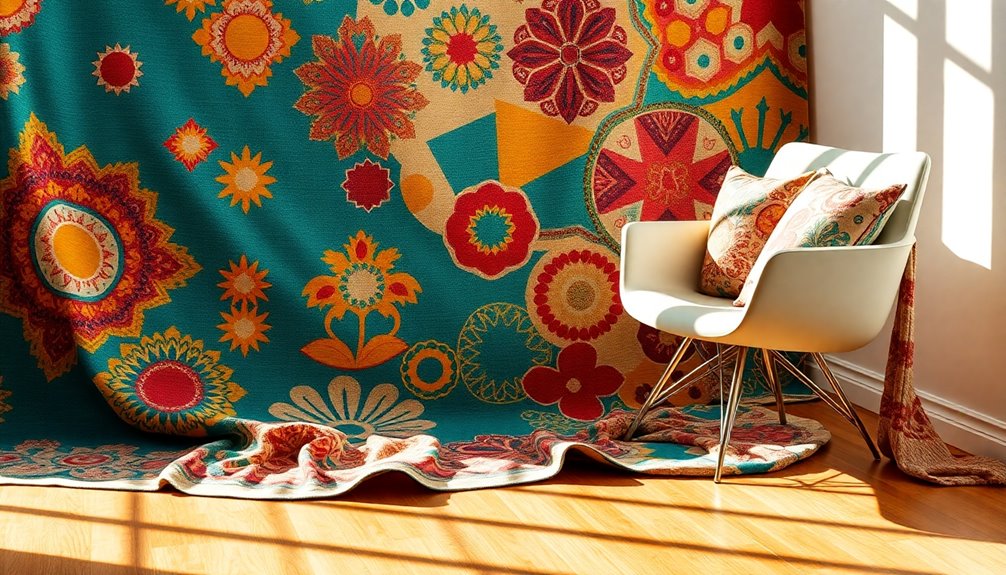
As textile design evolved, it seamlessly shifted from traditional hand-weaving and block printing to modern techniques like digital printing.
You'll notice this transformation in the 19th century, when industrialization revolutionized production methods, making diverse patterns and colors widely accessible.
By the mid-20th century, the introduction of synthetic fibers expanded your options in textile designs, offering greater durability and a variety of textures.
Today, contemporary designers focus on sustainability, prioritizing eco-friendly materials and processes that reduce environmental impact.
Thanks to technology, designers now utilize computer-aided design (CAD) to explore complex patterns and intricate motifs, pushing the boundaries of what textile designs can achieve.
This evolution not only showcases creativity but also enhances the functionality of textiles in your home décor. As we look ahead, it’s exciting to explore the trending textile patterns for 2025, which promise to bring fresh energy and vibrancy to our living spaces. From bold geometric designs to natural motifs that reflect sustainability, these patterns are set to redefine how we think about and use fabric in our homes. Embracing these trends allows for a harmonious balance between aesthetic appeal and practical usage, ensuring that every piece adds both beauty and purpose.
Color and Pattern: Setting the Tone
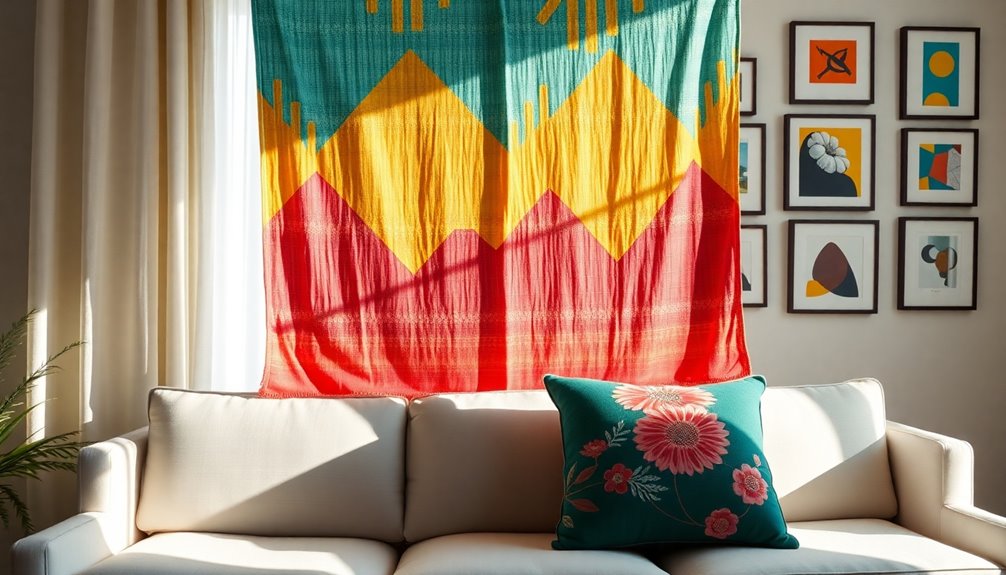
Color and pattern are powerful tools that can transform the atmosphere of any room. The right color palette sets the mood, whether you choose harmonious monochromatic schemes or energizing complementary colors. Patterns, too, greatly influence your space; modern home decor often embraces geometric designs, while traditional styles may favor floral or ethnic motifs.
| Color Palette | Pattern Style |
|---|---|
| Monochromatic Harmony | Geometric Modern |
| Complementary Energy | Floral Traditional |
| Soft Neutrals | Ethnic Motifs |
Remember that the scale and proportion of patterns should align with your room's size and furniture, while textures like velvet and linen add warmth and originality. Blending traditional patterns with modern interpretations can create a unique aesthetic. Additionally, incorporating energy-efficient designs can contribute to a more sustainable living environment while enhancing the overall aesthetic of your home.
Innovative Uses of Textiles in Interiors

Textiles play an essential role in modern interior design, offering endless opportunities to enhance your space. You can creatively integrate textiles in various ways, making your home both functional and stylish.
Consider these innovative uses:
- Transform flat surfaces into stunning wall art with fabric panels.
- Use textiles for room dividers that provide privacy while adding aesthetic charm.
- Incorporate heavy fabrics like velvet or wool for effective soundproofing.
Additionally, window treatments not only control light but also introduce layers of color and texture. Including natural materials in your textile choices can further enhance the farmhouse aesthetic of your interiors.
With the rise of smart fabrics, you can even have textiles that change color or pattern with ambient conditions, bringing dynamism to your modern interiors.
Embrace these ideas to elevate your home décor!
The Charm of Toile: A Historical Perspective

You might be surprised to learn that toile originated in Ireland and gained fame in France during the 18th century.
Its intricate designs, created with engraved copper plates, capture pastoral scenes that still resonate today.
As you explore modern interpretations, you'll see how traditional motifs blend seamlessly with contemporary themes to enhance your home décor.
Historical Origins of Toile
Although it may seem like a simple fabric, toile carries a rich history that dates back to its origins in Ireland before flourishing in 18th-century France.
The historical origins of toile can be traced to Jouy-en-Josas, where Christopher-Philippe Oberkampf perfected the art of intricate printing using engraved copper plates. This fabric not only enhanced interior design but also told stories through its detailed patterns.
Key aspects of toile include:
- Pastoral scenes: Early designs often depicted idyllic landscapes and narratives.
- Innovative techniques: The printing methods allowed for elaborate and vibrant designs.
- Cultural significance: Toile became a symbol of elegance and artistic expression in home décor.
Today, its charm continues to inspire modern interpretations.
Modern Interpretations of Toile
How does a centuries-old fabric maintain its charm in today's design world? Modern interpretations of toile create visually appealing spaces that blend tradition with contemporary flair. By incorporating playful motifs and clean lines, you can enhance your décor while inviting a whimsical spirit. Throw pillows adorned with reimagined toile patterns add visual interest and comfort to any room. Moreover, the use of natural materials in modern farmhouse decor further elevates the aesthetic, creating a harmonious balance with toile's classic elegance.
| Traditional Elements | Modern Adaptations |
|---|---|
| Pastoral scenes | Abstract motifs |
| Intricate detail | Simplified graphics |
| Earthy colors | Vibrant palettes |
| Handcrafted styles | Block printing techniques |
| Classic elegance | Eclectic charm |
With its enduring legacy, toile fabric allows you to create unique accent pieces that transform your home into a stylish retreat.
Modern Interpretations of Classic Motifs
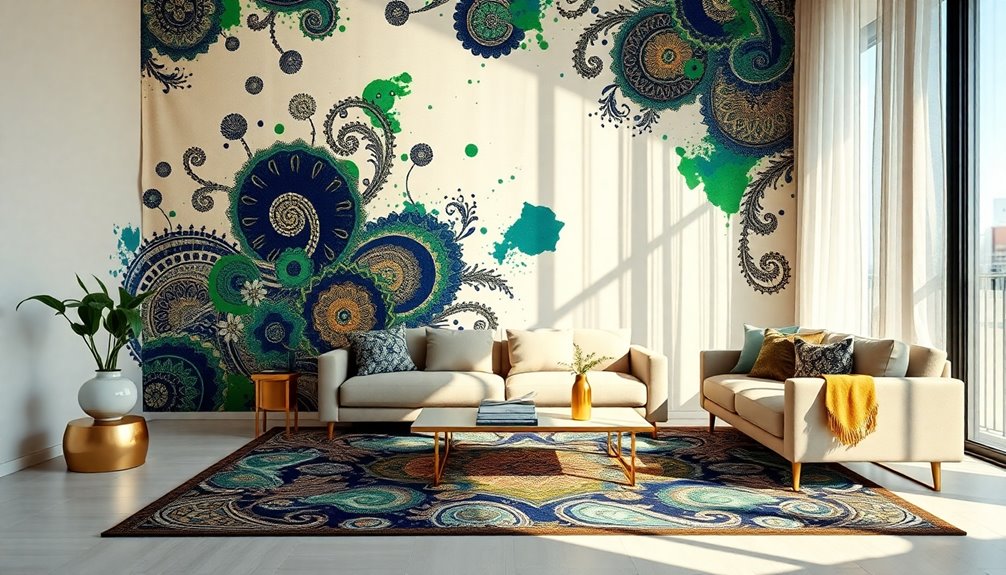
As designers explore modern interpretations of classic motifs, they're seamlessly blending traditional patterns with contemporary elements to create striking new aesthetics.
By reimagining historical designs, they incorporate vibrant colors and innovative materials that resonate with today's homeowners.
Consider these exciting trends:
- Geometric shapes alongside floral designs: This fusion modernizes classic patterns, offering a fresh twist.
- Digital printing technology: It allows for intricate details and a wider color palette, ensuring precision in design.
- Sustainable practices: Designers use eco-friendly materials, honoring traditional motifs while being mindful of the environment.
With these dynamic updates, classic motifs evolve, providing a perfect balance of nostalgia and modernity in your home décor. Additionally, incorporating natural elements can enhance the overall aesthetic, creating a harmonious blend of styles.
Personalizing Spaces Through Textile Choices

Classic motifs can set a beautiful foundation for your home, but personalizing your space through textile choices takes it a step further. When you select fabrics and patterns that reflect your tastes, you create a unique expression of style.
Layering textiles like throws, cushions, and rugs not only boosts comfort but also adds visual interest, allowing for seasonal updates. Choose colors and patterns mindfully, as they can greatly influence a room's mood.
Innovative uses, like fabric wall art or customized upholstery, can serve as focal points, enhancing your décor. Plus, opting for sustainable and eco-friendly fabrics lets you personalize your space while being kind to the planet. Incorporating natural materials into your textile choices can further enhance the rustic charm of your décor.
Embrace your individuality and transform your home with thoughtful textile choices.
Frequently Asked Questions
How Do I Choose the Right Textile for My Space?
Choosing the right textile for your space involves considering several factors.
Think about the room's purpose; durable fabrics work well in high-traffic areas.
Evaluate the color palette; choose textiles that complement your existing decor.
Don't forget about texture; mixing soft and rough materials adds depth.
Finally, consider maintenance; some fabrics require more care than others.
Trust your instincts and select what resonates with you to create a comfortable and stylish environment.
What Are Some Sustainable Textile Options for Home Décor?
When you're choosing sustainable textiles for your home décor, consider organic cotton, bamboo, and hemp. Each option's eco-friendly, durable, and stylish.
Organic cotton's soft and breathable, bamboo's naturally antibacterial, and hemp's known for its strength and longevity.
You can also explore recycled fabrics, which reduce waste and add unique character to your space.
Prioritizing sustainability not only enhances your home's aesthetic but also supports a healthier planet for everyone.
How Can I Mix Different Patterns Effectively?
Mixing different patterns effectively starts with choosing a cohesive color palette.
Select patterns that share a common color to create harmony. You can balance bold prints with more subtle ones, ensuring one pattern stands out while others complement.
Vary the scale of patterns – mix large florals with smaller geometric prints.
Finally, don't be afraid to experiment; lay out fabrics together to see how they interact, and trust your instincts for a stylish combination!
Are There Specific Textiles for Different Climates?
Absolutely, specific textiles suit different climates!
For hot, humid areas, lightweight fabrics like cotton or linen keep you cool. In contrast, wool or heavier blends work well in colder climates, providing warmth.
If you're in a damp environment, consider moisture-wicking materials to prevent mildew.
Always think about breathability and insulation, depending on your local weather.
Choosing the right fabric can enhance comfort and durability for your space, making a significant difference!
What Maintenance Is Required for Patterned Textiles?
Maintaining patterned textiles isn't too complicated, but it does require attention.
You should regularly vacuum or shake them to remove dust and debris. For spills, blot them immediately with a clean cloth instead of rubbing.
Depending on the fabric, you might need to wash them gently or dry clean them. Always check the care label for specific instructions.
With proper care, your patterned textiles will stay vibrant and beautiful for years to come.
Conclusion
In the world of home décor, textiles aren't just fabric; they're the whispers of your personality woven into every corner. By embracing innovative designs and timeless patterns, you're not just decorating—you're telling a story. So, as you curate your space, remember that each choice is a gentle nod to your unique style. Let your textiles embrace you, transforming your home into a sanctuary that reflects the beauty of who you are, while subtly elevating your everyday life.
